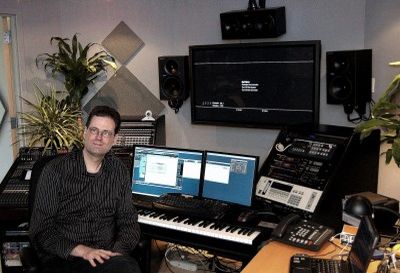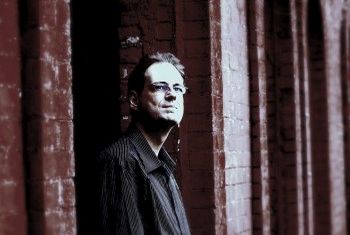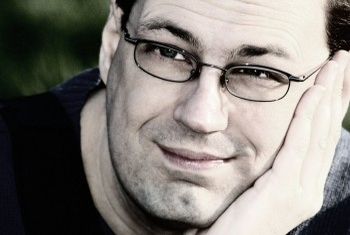Interview with Chris Huelsbeck
![]()
« Allister Brimble (July 2011) | Index | Enrico Colombini (April 2008) »
| (http://www.retrogamingplanet.it/intervista/dal-c64-alliphone-chris-huelsbeck-ed-i-suoi-30-anni-di-musica/) | >> SEE THE ARTICLE IN PDF FORMAT << |

|
Ring the bells, the drums roll!
This time Retrogaming Planet has brought him his hardest hit, surpassed himself, a real blow hunchback: Ladies and Gentlemen, here is your interview with Chris Huelsbeck, Commodore 64 and Amiga Soundtracker and a very good musician!
RGP: Hi Chris, first of all thanks for accepting the interview, despite your busy schedule! Let’s start from the beginning: what made you choose music and what instrument did you start with?
CH: My Grandma, Mom and Aunt were all Piano Teachers and music was always a big part of my family. So of course I had my first steps on the Piano around age 5, but I gave up learning to play other peoples music after 2 years, since I would rather play my own melodies. I also tried to learn how to play Drums and took a few lessons.
Later in my teenager years, I became very interested in electronic music and Synthesizers, but they were too expensive, so I actually build my own simple synth that I called “Zarg”.![]()
RGP: Tell us something about your first contact with a computer and the choice of using it for your music as an alternative do traditional tool?
CH: That actually ties in right with the last question. I had started programming in Basic on my Uncle’s business computer for a while, but realized that I needed my own Computer. When I first read that the Commodore 64 had a real synthesizer sound chip, I was very excited.
I had saved up some money, but it was still not enough for the C64 and I almost bought the cheaper Atari 800 because I wanted a computer so bad. Finally, my Grandmother gave me some more money so I could get the machine that I really wanted; my very own C64.![]()
RGP: The choice of writing music for the videogame field has probably come from a particular machine and game title, do you confirm this and if so, which of both?
CH: I originally wanted to create my own games, but my programming and graphics skills were not quite strong enough at the time and a friend of mine was much better at that. But he was not good with sound and music in particular, so I helped him out with my first game music ever: the music for Planet of War.

|
RGP: At the age of 16 the event that launched your career, a contest by the German magazine “64er magazine”… Can you tell something about that?
CH: After Planet of War I was already improving my machine language music player and when I read about the contest, I was determined to get at least noticed by sending in a cool music piece. I never expected to win, but of course I was very happy about my prize and it helped to start my career.![]()
RGP: …and after a short while your new career in Rainbow Arts! What did it mean, for you, working for one of the most famous software companies of the time, at the young age of 18?
CH: It was a very cool and exciting time, because they gave me a lot of freedom and a decent salary that many young people starting out in a job probably don’t have. It helped me to develop cool programming tricks to get more and more out of the C64 sound chip, like the digitized drums and samples for example.![]()
RGP: During that period you’ve been working hard on the Commodore 64 platform and the effort was clearly shown in your production: R-Type, Turrican and Katakis are just some of the titles based on your soundtracks, but they show absolutely unique skills and composition vein! But there’s been a title, in particular, which gave you most of your fame, and we’re talking about The Great Giana Sisters which created so many troubles in relation to Nintendo (because of the way it resembled Super Mario Bros)… were GGS’s tracks inspired by something in particular?
CH: The ingame music was supposed to sound a little like Reggae, because the Rainbow Arts Boss was a fan of Bob Marley & others and the Title music (not to mistake with the menu music, which many people believe to be the title music) was a homage to True Blue from Madonna, also one of his favorites. In the end I think, despite the inspirations, the songs have their own character and are the only part of the game that wasn’t heavily borrowed from Super Mario Brothers, which is something I am proud of.
VIDEO MUSIC INSPIRED ON MADONNA’S TRUE BLUE![]()
INTRO MUSIC THE GREAT GIANA SISTERS C64![]()
INGAME MUSIC THE GREAT GIANA SISTERS C64![]()
RGP: What hardware and software tools did you use for your music production and what kind of workflow did you follow in creating a soundtrack?
CH: I had 2 C64, one with the programming source code and another one for the actual music creation and playback. I used my own Music Editor, the so called Soundmonitor and later a follow up called TFMX Editor to input the music data, which was a lot of numbers in hexadecimal format. For the musical notes, I had a special representation that displayed the hex numbers in a more musical readable format (like ‘A-2’ or ‘G#3’ for example). Other programs that came later, like the Trackers on the Amiga used a similar format and they may have been inspired by my earlier tools. With the help of a friend of mine, I also made a little hardware sampler for the C64; to record all those digitized drums, bass sounds and SFX for Jinks, Bad Cat, Antics, To Be On Top and Giana Sisters. And Rainbow Arts also provided me with my first synthesizer keyboard, the Ensoniq ESQ-1, sponsored by the company, that I used to compose and preview my melodies.![]()
RGP: After so much hard work for the Commodore 64 you changed to work on the Amiga platform, thanks to the cooperation with Factor 5… was the transition from the SID to Paula (respectively used in the C64 and Amiga, for our readers) flawless or did you struggle with some difficulties (again, for our readers we must remember how Paula was appreciated for its management of 32KHz 8-bit PCM samples on four stereo channels)?
CH: As much as I loved and still love the C64 SID sound, I saw the Amiga with it’s 4 hardware sample voices as a big step up, since you could use pretty good quality digitized sounds to make music, like real drums or even complete sampled chords.![]()
RGP: Would you like to tell something about the tool you developed for the Amiga, used to obtain unrivaled results in the creation of soundtracks?
CH: The basic concept of my music tool TFMX came directly from the C64 version, specially the way a single sound was generated. I had developed a simple but powerful script language, that was run for every note played. I often used this to play very short drum sounds with a fixed pitch just before a pitched bass sound for example and it would sound like 2 channels were used at the same time, because the human brain can’t keep sounds apart that are played in very short succession. Some time later I also used a software mixer to mix down 4 simulated Amiga channels into one of the hardware channels to get a total of 7 channels. This was achieved with the help of a colleague of mine, Jochen Hippel, who had programmed an Amiga Sound Emulator for the Atari ST.

|
| TFMX-EDITOR by Chris Huelsbeck |
RGP: The technical limits of Amiga (which wasn’t able to use seven tracks simultaneously ingame but only in intros and closing titles) and the reduced memory space on floppies werenìt enough to stop you from creating fantastic soundtracks that we still remember. What are the titles You still remember with most “affection”?
CH: Definitely the Turrican Series, but also our KAIKO games, like Apidya and GEM’X. And another one of my favorites from a music perspective is Jim Power. Some of the songs in ‘Jim Power’ use only 40kb, they would have fit into a C64… 
JIM POWER AMIGA![]()
APIDYA AMIGA![]()
RGP: Your production, though, wasn’t restricted to Commodore home computers: we know that you’ve been working on the Sega Mega Drive, Super Nintendo and subsequently even on the Playstation going through the Nintendo 64 and finally landing on the GameCube. How did you musical approach change in the transition from one to another of those machines, so different from each other both in hardware and in software?
CH: After the Commodore era was coming to an end, I just continued to develop my tools for other platforms. Each machine had their advantages and challenges, but they usually had more channels and more features with every generation.![]()
RGP: In 1996 Factor 5 collaborated with Lucas Arts and your production, subsequently, was tied to the Star Wars saga game titles, for which you created soundtracks perfectly aligned with John Williams’ original scores! On the Nintendo 64 (knowingly not suited for orchestral soundtracks) you’ve been using a dedicated software tool called MusyX. What can you tell us about that experience?
CH: Yes, with the help of Factor 5, we created this new music tool (extending on my previous concepts), which was actually later licensed by Nintendo as their official Sound Tool for the N64. The challenge for the Star Wars games was to recreate a full orchestra with only 16–24 channels and still limited memory for the samples. That’s the reason they asked me to come to the USA to work on this project, because there were still not many guys who could do this at that time. It was not easy to create music that fit into the Star Wars Universe and John Williams is a hero of mine, so I tried hard not to disappoint.![]()
RGP: A few years ago most of your great tracks have been rearranged for an orchestral performance and performed in several occasions during the Symphonic Game Music Concert in Lipsia. Is there any recording available of those concerts?
CH: They were only allowed to play the music for that particular event, but unfortunately not allowed to record it, due to the many different license holders involved. But the same producer, Thomas Boecker put on another concert in 2008 called Symphonic Shades which was featuring my music exclusively and is available as an Album on iTunes & Co (searching Chris Huelsbeck Symphonic Shades on YouTube to listen the Chris Huelsbeck’s tracks in symphonic version!! - NdRGP).
APIDYA II SYMPHONIC ORCHESTRA![]()
THE GREAT GIANA SISTER SYMPHONIC ORCHESTRA![]()
RGP: We haven’t seen your name related to videogames titles, lately… what’s your primary job at the moment?
CH: I am once again working as a freelance composer and offer my services at Chris Huelsbeck Productions, including sound design. Lately I’ve finished music and SFX for a number of iPhone Games, like ZombieSmash, R-Type, Kubrik and Subsolar. I’m also working on a new browser game called Star Trek – Infinite Space, which should be finished soon.
I’m also collaborating with Sound of Games, which is a band that I joined last year to perform music from video games (including mine) on stage at game/trade shows and other events.
We have more gigs planned this year… 
![]()
RGP: Is there any way to get recording collections of your videogame “discography”?
CH: I have recorded a lot of my music pieces in the studio over the years and released a number of Albums on CD. Most of them are sold out now, but all of them are still available on iTunes and other legitimate music download sites (link here to buy the Chris Huelsbeck’s album from iTunes - NdRGP).![]()
RGP: What’s your advice or suggestions to young musicians wanting to start a profession like yours?
CH: Besides some talent, it takes a lot of determination and time to get started, so it’s not for the short term. Jobs in this field are almost always received through personal connections or referrals, so strong social skills are at least as important as artistic skills. You need to personally meet and hang out with the people who decide about music and sound in their games and one good way are Game Developer Conferences and big shows like the E3.
A good uncluttered website is important, just as staying on top of the trends with social sites. Put your demo reels online and hand out the web address or remind everyone where to find your demos when you follow up by email. But don’t pester the people… if they like what they hear in your demos, they will keep you in mind for when the time is right. These days, a solid music education is also a big plus. There are also many online resources and the Game Audio Network Guild (G.A.N.G.), which is a special organization dedicated to game audio.
| UPDATE #1 |
RGP: Some readers, after a careful reading of the interview, have asked to me what was the actual hardware used by Chris… Obviously Retrogaming Planet has turned the question to Chris who kindly replied:
CH: In the mid 90s I had a quite large studio setup with many Synthesizers, Samplers, other rack gear, Digital Mixer and huge amount of cables. But these days I use pretty much only virtual instruments.
All the sound production happens inside the computer with Steinberg Cubase and many high end plugins, like East West QL Symphonic Orchestra, Stormdrum, RA, Spectrasonics Stylus RMX, Korg Legacy Collection, Native Instruments Pro-53, FM7, ReFX Nexus & QuadraSID & countless others.
I actually often use 2 or 3 computers at the same time (all connected via Vienna Ensemble Pro), specially for the larger orchestral sample libraries. The only classic studio hardware that I still use on a regular basis is a Kurzweil K2500 as my master midi keyboard and controller.
To get the sound out of the computer I use a RME Hammerfall DSP system & Multiface and my audio monitoring is done with a Mackie 1402-VLZ Pro, Mackie Big Knob and active speakers plus subwoofer.
| UPDATE #2 |
After the publication of the interview I received two interesting contacts!
The first, directly from the Creator, the development of unofficial sequel to The Great Giana Sisters for all existing operating systems (including Ubuntu 32/64 bit!). More information about supported operating systems, screenshots of the game and real-time updates on the development, are available at this address.
The second contact concerns the publication of an E-magazine for young people where they speak for Rainbow Arts and creator of Turrican and The Great Giana Sister Chris Huelsbeck. More information available at this address.
RGP: That’s all for this interview, Retrogaming Planet’s readers will surely find it very interesting. So, let me thank you very much for your time and kindness and of course for all the beautiful emotions your music arose in our gaming experiences!
CH: Thank you for your interest in my work! 

|
Chris Huelsbeck
Composer / Sound designer
Chris Huelsbeck Productions
http://www.huelsbeck.com/
synSONIQ Records, Game Music Label
http://www.synsoniq.com/
Member of NARAS; IGDA; G.A.N.G.
Game Audio Network Guild Gold status with over 75 game projects
February 2011, Robert Grechi

 )
)